Physical Address
304 North Cardinal St.
Dorchester Center, MA 02124
Complex regional pain syndrome (CRPS) is the term that refers to a painful and disabling disorder that was first described during the United States Civil War. Nomenclature relating to CRPS has varied over the years and has included Sudeck's atrophy, reflex sympathetic dystrophy (RSD), posttraumatic dystrophy, and causalgia. CRPS has a variable presentation, and no single test exists to confirm the diagnosis. The disorder usually follows tissue injury or surgery to a limb (although it may have a spontaneous onset ) that may be associated with sensory, vasomotor, sudomotor, motor, and dystrophic changes ( Table 40-1 ). The pain is distinct in that it is out of proportion to the inciting event and may be accompanied by discoloration of skin ( Fig. 40-1 ), change in skin temperature, abnormal sweating, edema, and loss of the normal range of motion of the affected limb.
|
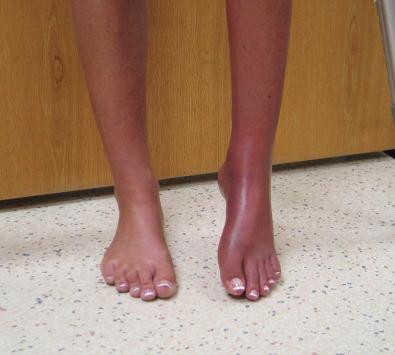
In 1994, the International Association for the Study of Pain (IASP) established a definition of CRPS to accommodate the various presentations, hypothesized pathophysiology, and anatomical structures involved. The diagnostic criteria for CRPS recommended by the IASP involved four factors:
The presence of an initiating noxious event, or a cause of immobilization
Continuing pain, allodynia, or hyperalgesia in which the pain is disproportionate to any known inciting event
Evidence at some time of edema, changes in skin blood flow, or abnormal sudomotor activity in the region of pain (can be sign or symptom)
This diagnosis is excluded by the existence of other conditions that would otherwise account for the degree of pain and dysfunction.
In addition, the physician was instructed to diagnose CRPS-I if the criteria existed without “major” nerve damage and to diagnose CRPS-II if the criteria were found in the presence of major nerve damage. In this respect, the region of disproportionate pain was believed to originate initially within a dermatome. As the disease progressed, it could spread beyond a single dermatome.
Although the standardized, internationally recognized terms of CRPS-I and CRPS-II were made available more than 3 decades ago, there continued to be inconsistencies in the literature that focused on this disorder. These were mainly believed to be caused by the poor specificity that existed for the IASP criteria, which lead to a high rate of false-positive diagnoses. In response to this problem, an international consensus conference was held in Budapest in 2003 with the goal of improving the IASP criteria. The resulting diagnostic criteria for CRPS, known as the “Budapest Criteria”, were found to have excellent sensitivity and specificity ( Table 40-2 ). The Committee for Classification of Chronic Pain of the IASP approved these criteria and will use them in upcoming revisions of their formal classification and diagnostic criteria for pain states.
| General Definition: |
| CRPS describes an array of painful conditions that are characterized by a continuing (spontaneous and/or evoked) regional pain that is seemingly disproportionate in time or degree to the usual course of any known trauma or other lesion. The pain is regional (not in specific nerve territory or dermatome) and usually has a distal predominance of abnormal sensory, motor, sudomotor, vasomotor, and/or trophic findings. The syndrome shows variable progression over time. |
| To Make the Clinical Diagnosis of CRPS, the Following Criteria Must Be Met: |
|
Much debate continues regarding the etiology and pathophysiology of CRPS. There are potential peripheral, afferent, efferent, and central mechanisms. The pain generator in CRPS has historically been described as being either sympathetically maintained pain (SMP) or sympathetically independent pain (SIP), depending on whether or not the sympathetic nervous system is involved. A sympathetic nerve block has been recommended to determine how much of the patient's pain is “SMP” and how much is “SIP.” The pain relieved by the block has been hypothesized to be SMP, although the remaining pain represents SIP. However, recent research has questioned this explanation of pain and other signs and symptoms of CRPS, which appear to be more centrally involved, as will be discussed later.
Despite the complexity of the definition of CRPS, the hallmark of this disease is pain usually starting in an arm or leg that is out of proportion to the inciting event of trauma or surgery. Recent research has shown that, despite prior beliefs, CRPS is not significantly associated with a history or presence of psychological problems. The early diagnosis and treatment of this disorder is crucial because early management yields a more favorable outcome. If not successfully managed, CRPS patients have a major loss of quality of life and will most likely experience psychological consequences of their chronic pain. This chapter covers basic relevant anatomy, proposed etiology and pathophysiology, clinical presentation, diagnosis, and treatment options for CRPS. It is important to note that controversy and a lack of consensus exists within the medical community regarding these issues.
Review of nervous systems, autonomic system uses two-neuron pathway from central nervous system to peripheral organ, called sympathetic and parasympathetic nervous systems.
Postganglionic parasympathetic neurons release acetylcholine, postganglionic sympathetic nerve fibers release norepinephrine, neurotransmitters involved with CRPS.
Review afferent, efferent neurons, dorsal root ganglions, synapses.
Sympathetic nervous system responsible for the fight-or-flight response, mediated by catecholamines epinephrine and norepinephrine, substance P.
Catecholamine neurotransmitters stimulate α and β receptors. Stimulation α receptors: elevated heart rate and blood pressure, piloerection, and skin vasoconstriction. Stimulation β receptors: increased heart rate, muscle vasodilation, and bronchial dilation.
Stellate ganglion supplies majority of sympathetic innervation to upper extremities, lumbar paravertebral ganglia supplies lower extremities.
Nerves around knee and lower limb: femoral, obturator, common peroneal, tibial, saphenous, medial retinacular.
To understand the basis of the proposed etiology and pathophysiology of CRPS, the clinician must have an understanding of the human nervous system anatomy and function. Detailed knowledge of the innervation of the knee joint and lower limb is also required because in many instances, this disorder begins from obvious peripheral nerve injury or minimal injury or degeneration of small distal nerves.
The human nervous system is divided into the central nervous system (CNS, the brain, spinal cord) and the peripheral nervous system (PNS, composed of cranial nerves, spinal nerves, and peripheral nerves with their motor and sensory endings). The PNS has sensory neurons that run from stimulus receptors to the CNS and motor neurons that relay information from the CNS to the muscles and glands. The PNS is subdivided into the somatic and autonomic nervous systems.
The somatic nervous system consists of cranial nerves (12 pairs), spinal nerves (31 pairs) ( Fig. 40-2 ), and association nerves. It is the consciously controlled part of the PNS. Functions of this system include smell, vision, movement (stimulation of skeletal muscles), facial and mouth sensation, chewing, taste, swallowing, hearing, and balance.
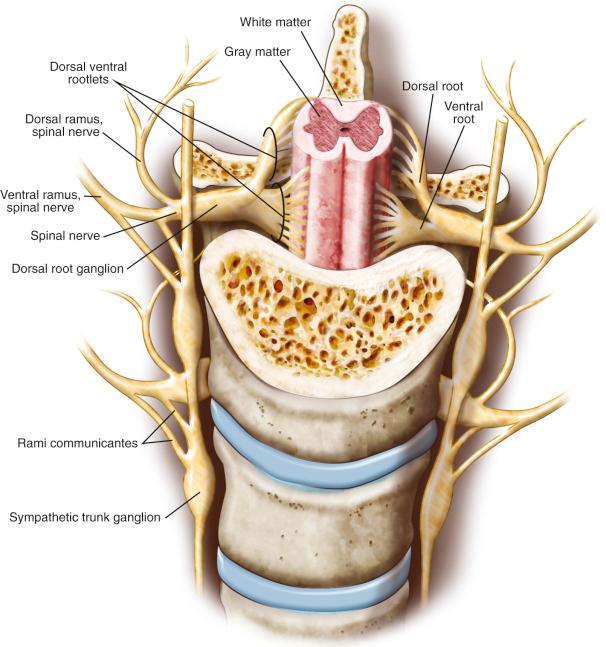
The autonomic system controls the subconscious actions of cardiac muscle, smooth muscle, and glands. This system uses a two-neuron pathway from the CNS to the peripheral organ, known as the sympathetic and parasympathetic nervous systems that are described in detail later. There are two nerve fibers in this pathway termed preganglionic and postganglionic . The preganglionic neurons arise in the CNS and run to a ganglion in the body. They then synapse with postganglionic neurons, which run to the effector organ. Various neurotransmitters are frequently involved with this process, as we will describe later. For instance, postganglionic parasympathetic neurons release acetylcholine, while postganglionic sympathetic nerve fibers release norepinephrine.
Neurons process and communicate information within the body by transmitting electrical and also frequently electrochemical signals to other neurons or effector cells. A typical neuron contains a cell body, dendrites, and an axon ( Fig. 40-3 ). Many axons are covered with a myelin sheath, which is an expanded plasma membrane of an accessory Schwann cell. There are areas where space exists between the sheath of Schwann cells, known as the node of Ranvier. These areas contain voltage-gated sodium channels, whereby depolarization sweeps along the cell. When depolarization reaches threshold, an action potential is generated. This in turn triggers the release of neurotransmitter chemicals, which will be discussed later.
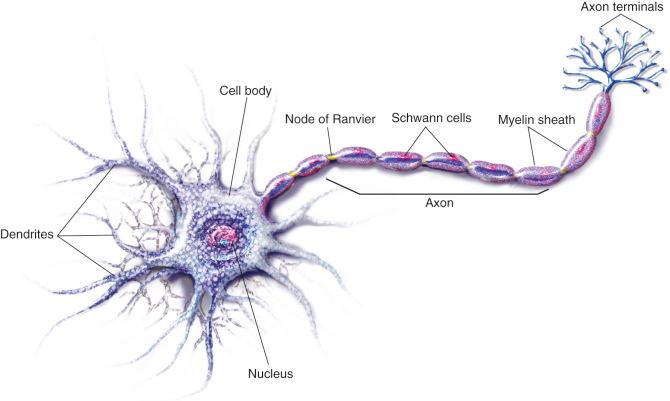
Information is usually processed from the axon of one neuron to a dendrite of another, although there are exceptions to this rule. Dendrites frequently branch profusely and the axon may extend for a great distance, giving rise of hundreds of branches. There are three types of neurons:
Afferent neurons (sensory neurons) transmit sensory signals from receptors or sense organs to the CNS. These neurons have an axon that extends to the periphery and another axon that extends into the CNS via the dorsal root. The cell body of these neurons is located in the dorsal root ganglion or a sensory ganglion of sensory cranial nerves ( Fig. 40-4 ). The ventral and dorsal rootlets join together to form the root of a peripheral nerve. Specialized somatic sensory nerve endings known as nociceptors, mechanoreceptors, and thermoreceptors perceive pain stimuli, pressure stimuli, and temperature stimuli.
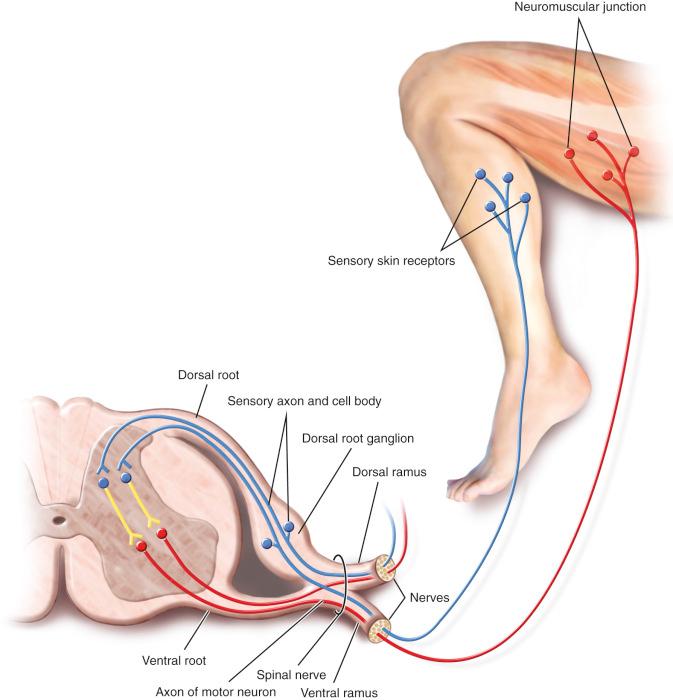
Efferent neurons (motor neurons) transmit signals from the CNS to effectors in the body such as muscles and glands. They project their axons outside the CNS to directly or indirectly to control muscles. These include somatic and visceral motor neurons.
Interneurons form complex networks within the CNS to integrate information between sensory and motor neurons.
Ganglions represent a group or nodule of cell bodies of sensory nerves (neurons) that are usually located outside the brain and spinal cord. There are two major types of ganglions: dorsal root (spinal) and autonomic.
Dorsal root ganglions are located on dorsal roots along the vertebral column of the spine ( Fig. 40-5 ). It is through dorsal root ganglions that somatasesensory information from afferent sensory nerve fibers are transmitted (representing pain, pressure, and temperature) to the spinal cord. Each sensory neuron in the dorsal root ganglion has a long axon which relays information to the spinal cord and ultimately to the brain in the parietal cortex.
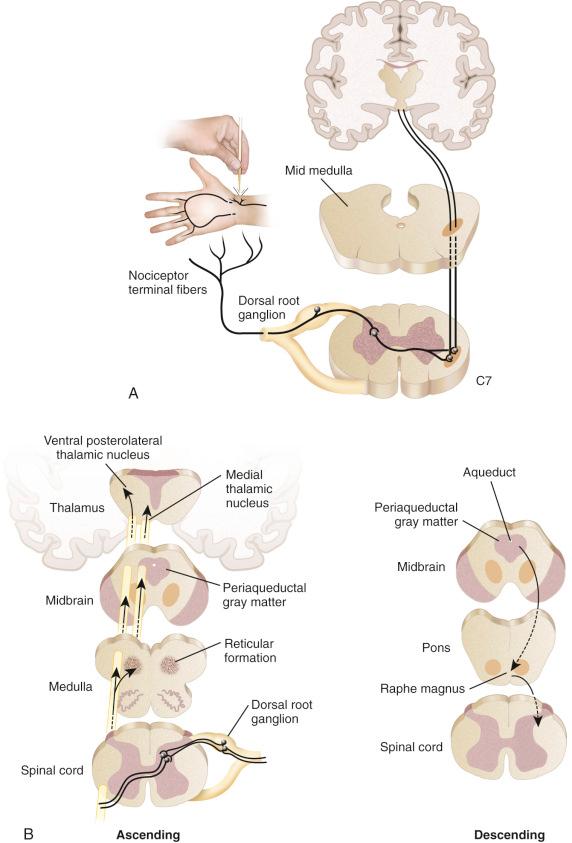
Autonomic ganglions are part of the autonomic nervous system and are located along the sympathetic trunks, on the peripheral plexuses, and within the walls of organs.
A synapse is the gap between a neuron and another cell ( Fig. 40-6 ). Synapses may form between two neurons or between a neuron and an effector cell. In a typical synapse, contact occurs between the axon of one neuron and a dendrite or cell body of another.
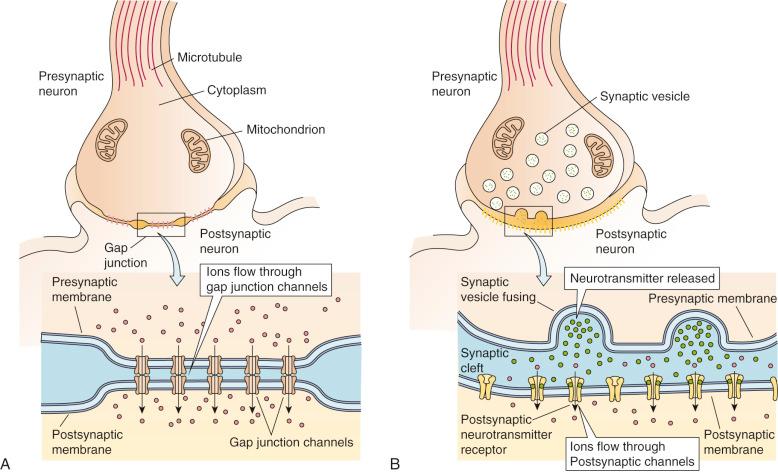
Electrical synapses take place between two apposed neurons. The nerve transmission occurs by the passage of ions from one neuron to the other through gap junction channels. Electrical synapses occur much faster than electrochemical synapses.
An electrochemical synapse represents a junction that occurs between neurons or between a neuron and an effector cell via release of neurotransmitters that result in physiologic reactions.
Neurotransmitters are either excitatory , whereby they increase the likelihood that a neuron will fire an action potential, or inhibitory , in which they decrease the chance of a neuron firing an action potential. Major excitatory neurotransmitters include epinephrine and norepinephrine and some inhibitory neurotransmitters are serotonin and gamma-aminobutyric acid. Acetylocholine and dopamine may be either excitatory or inhibitory, depending upon the type of receptors that are present. Other neurotransmitters include various endorphins, enkephalins, and neuropeptides such as substance P.
Acetylcholine is widely used at synapses in the neuromuscular junction; including motor neurons activating skeletal muscle, preganglionic neurons of the autonomic nervous system, and postganglionic neurons of the parasympathetic branch of the autonomic nervous system. Epinephrine (adrenaline) is considered a crucial component of the fight-or-flight response of the sympathetic nervous system and is released in substantial quantities when the body is under stress. Noradrenaline (norepinephrine) is released by postganglionic neurons of the parasympathetic branch of the autonomic nervous system.
At the end of a neuron's axon is an enlarged area known as the axon terminal, which is separated from the next cell by the synaptic cleft. Neurotransmitters release their contents by exocytosis into this cleft. The chemicals are received by receptor sites in the dendrites of the receiving neuron. When enough receptor sites have been filled, the receiving neuron sends the neuron impulse down its axon to its terminal fibers. The neurotransmitter is immediately inactivated by an enzyme.
In summary, before a sensory signal can be relayed to the nervous system, it must be transduced into an electrical signal in a nerve fiber. This involves a process of opening ion channels in the membrane in response to mechanical deformation; temperature; or, in the case of nociceptive fibers, signals released from damaged tissue. Many receptors become less sensitive with continued stimuli, termed adaptation. The adaptation may be rapid or slow, with rapidly adapting receptors being specialized for detecting changing signals.
There are encapsulated and nonencapsulated receptors in the skin. The nonencapsulated endings include free nerve endings, the peripheral end of the sensory axon. These mostly respond to noxious (pain) and thermal stimuli. Injuries to peripheral nerves may affect sensation and strength, resulting in severe weakness and muscle atrophy over time.
The sympathetic nervous system is responsible for the fight-or-flight response. This reaction is mediated by catecholamines, including epinephrine and norepinephrine. The term adrenergic refers to synapses in which epinephrine is used, although noradrenergic refers to synapses in which norepinephrine is used. Another neurotransmitter important for the sympathetic nervous system and CRPS is substance P, which is responsible for transmission of pain from certain sensory neurons to the CNS and aids in controlling relaxation of the vasculature and lowering blood pressure.
These catecholamine neurotransmitters stimulate α and β receptors. The stimulation of α receptors results in elevated heart rate and blood pressure, piloerection, and skin vasoconstriction. The stimulation of β receptors results in increased heart rate, muscle vasodilation, and bronchial dilation.
Sympathetic nerve fibers originate inside the vertebral column at the first thoracic segment and extend to the third lumbar segment. Because the cells begin in both the thoracic and lumbar regions of the spinal cord, the sympathetic nervous system has a thoracolumbar outflow. Axons of these nerves leave the spinal cord and pass near the spinal ganglion.
The paravertebral ganglia , also termed the sympathetic chain or trunk, are a series of paired chains of ganglia that lie parallel to the vertebral bodies of the spinal column. The ganglia are interconnected to each other by nerve fibers and extend from the base of the skull down to the coccyx. There are three sympathetic chain ganglia located at the cervical level. The most inferior of these is the stellate ganglion which is believed to the supply the majority of the sympathetic innervation to the upper extremities. In the lower extremities, the sympathetic innervation is carried through lumbar paravertebral ganglia.
All preganglionic motor neurons originate within the spinal cord and postganglionic fibers always originate in the PNS within a ganglion. There are 22 to 23 pairs of sympathetic chain ganglia. The interaction of nerve fibers begins at the spinal cord where they arise at the thoracolumbar region (T1-L2) and emerge via the ventral nerve root. They enter the sympathetic chain through the white rami communicans.
There are three options available to the preganglionic neurons in the sympathetic ganglion: (1) synapse with postganglionic neurons, (2) pass up and down the sympathetic chain, and (3) leave the ganglion using a cord that leads to a special ganglia in the viscera. It is this ability to move superiorly and inferiorly along the chain that results in the mass response to the sympathetic nervous system. A preganglionic fiber may synapse to 15 to 20 postganglionic fibers. Sympathetic postganglionics from the chain enter the gray rami communicans and go back to the spinal nerves to be distributed to somatic tissues of the limbs and body walls.
The sympathetic nervous system innervates all vascular smooth muscle (vasomotor function for blood pressure control and distribution control), all sweat glands (sudomotor control: core temperature control), and all arrector pili smooth muscle of hair follicles (pilomotor function: temperature control). Stimulation of the sympathetic nervous system results in:
Dilation of pupils
Stimulation of sweat glands
Accelerated heart rate
Increased blood pressure
Increased blood glucose levels
Relaxed bronchial muscles
Reduction of saliva and mucus
Reduction digestive activity, urine secretion
There is a dual innervation of most organs of the body by the sympathetic and parasympathetic divisions. In these cases, one will inhibit and the other will excite, providing the opposite effect such as speeding or slowing of heart rate.
The parasympathetic nervous system is composed mainly of the cranial and sacral spinal nerves. The preganglionic neurons, arising from either the brain or sacral spinal cord, synapse with just a few postganglionic neurons which are located in or near the effector organ (muscle or gland). The parasympathetic nervous system is responsible for the body's rest and digestion response when the body is relaxed, resting, or feeding. It basically undoes the work of sympathetic division after a stressful situation. The parasympathetic nervous system decreases respiration and heart rate and increases digestion. Stimulation of the parasympathetic nervous system results in:
Construction of pupils
Decreased heart rate and blood pressure
Constriction of bronchial muscles
Increase in digestion
Increased production of saliva and mucus
Increase in urine secretion
The major nerves around the knee and lower limb are shown in Figure 40-7 . The two plexi that contribute to the innervation of the lower limb are the lumbar plexus and sacral plexus. The lumbar plexus (L2-4) gives rise to the femoral and obturator nerves . The obturator nerve innervates obturator externus, adductor brevis, adductor longus, adductor magnus, and gracilis. The femoral nerve innervates the iliacus, pectineus, all four heads of quadriceps, and sartorius. The terminal cutaneous branch of the femoral nerve is the saphenous nerve, which will be discussed in detail.
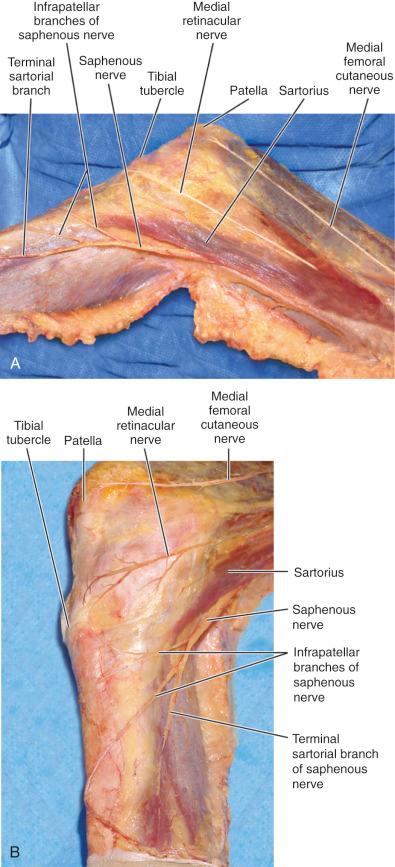
The sacral plexus (L4-5, S1-S3) forms the sciatic nerve, which passes deep to biceps femoris and divides into the common peroneal nerve (common fibular nerve) and the tibial nerve at the popliteal fossa. The tibial nerve innervates the popliteus, gastrocnemius, soleus, and plantaris. The common peroneal nerve innervates the peroneus longus, peroneus brevis, and short head of the biceps femoris muscles. The tibial nerve is the larger of the two divisions of the sciatic nerve. It runs vertically through the popliteal fossa directly underneath the fascia and is the most superficial of the neurovascular structures behind the knee. The common peroneal nerve separates from the tibial portion of the sciatic nerve at the apex of the popliteal fossa and then follows the tendon of the biceps femoris along the upper lateral margin of the popliteal fossa to the back of the head of the fibula. The nerve then winds round the neck of the fibula and passes deep to the peroneus longus muscles and divides into the superficial and deep peroneal nerves.
On the medial side of the knee lies the saphenous nerve with its sartorial and infrapatellar branches, the medial femoral cutaneous nerve, and the medial retinacular nerve. The infrapatellar branch may follow four different courses at the medial joint line, which are described according to the nerve's relationship to the sartorius muscle. The medial femoral cutaneous nerve may travel superficially to the sartorius muscle, but is often found in Hunter's canal where it perforates the sartorius or exits deep to the sartorius. The medial retinacular nerve resides near the vastus medialis. A more detailed description of the innervation of the knee joint may be found in Chapter 39 .
In the senior author's (F.R.N.) experience, many cases of knee CRPS-II are related or most likely directly caused by injury to the saphenous nerve or its branches. Injury may occur by direct trauma or contusions, or by surgical procedures on the medial side of the knee. Formation of a neuroma may result from direct injury by the scalpel during arthroscopic anteromedial portal placement. Techniques for avoiding injury to these structures include careful dissection through a 1-cm incision with identification of the nerve, transillumination with use of the arthroscope, and use of a 2-cm posteromedial incision with posterior retraction to deflect the needles anteriorly during inside-out medial meniscal repair.
CRPS involves central, autonomic, and somatic nervous systems.
CRPS may be influenced by neurogenic inflammation and an immunologic response.
CRPS may create central sensitization and induce cortical reorganization.
Chronic CRPS may result in tissue ischemia/hypoxia from endothelial dysfunction and impaired circulation, severe psychological distress, and neuropsychological impairment.
CRPS-II results either from obvious nerve injury/neuroma or minimal injury/compression/degeneration of small distal nerves.
CRPS may be caused by abnormal increase in sympathetic nervous system activity after a stimulus (injury or surgery). However, role of sympathetic dysfunction questionable as the disorder progresses over time.
Several theories have been devised to explain the etiology and pathophysiology of CRPS. This chapter provides a summary of the more recent systematic reviews regarding these topics, most of which discuss CRPS in general and not specifically as it relates to the knee joint. Investigators typically agree that this disorder involves the central, autonomic, and somatic nervous systems; may be influenced by neurogenic inflammation and an immunologic response; creates central sensitization; and may induce cortical reorganization. In the chronic state, tissue ischemia/hypoxia may result from endothelial dysfunction and impaired circulation, and severe psychological distress and neuropsychological impairment may occur.
It is known that surgery as benign as knee arthroscopy can injure nerve structures and precipitate CRPS-II, although the reported incidence has been less than 0.1%. Historically, a survey study conducted by the Arthroscopy Association of North America (AANA) of member orthopaedic surgeons in 1986 reported that 229 nerve injuries occurred during 375,069 arthroscopic knee procedures. These included 97 saphenous nerve injuries, 11 peroneal nerve injuries, 7 femoral nerve injuries, 6 sciatic nerve injuries, and 108 tourniquet related or unspecified injuries. A more recent study reported 3 peripheral nerve injuries occurred in 12,271 patients who underwent knee arthroscopy.
In historic outcome studies, knee surgery was frequently reported as the trigger for RSD, although whether this represented CRPS-I or CRPS-II cannot be determined with certainty. O'Brien and coworkers described 60 patients referred for RSD of the knee. Of these, 40 had developed symptoms after knee surgery (24 arthroscopic and 12 arthroplasty procedures). One patient in this cohort had a neuroma identified as the potential trigger. Katz and Hungerford reported the results of 36 patients treated for RSD of the knee, on whom 15 had knee surgery (6 arthroscopies, 5 total knee replacements, 1 patellectomy, 1 high tibial osteotomy, 1 medial arthrotomy, 1 Maquet tibial tubercle osteotomy). Six patients in this study had nerve injuries, two involving the peroneal nerve and four involving neuroma formation at the infrapatellar branch of the saphenous nerve. In 1988, Poehling and associates described a series of 35 patients who developed RSD following injury to the infrapatellar branch of the saphenous nerve. These authors noted avoidance of trauma to this nerve during surgery was paramount, as was the early detection and initiation of treatment of RSD signs and symptoms.
In many instances, CRPS begins from obvious peripheral nerve injury, and the diagnosis of CRPS-II is definitive; however, it may also stem from a minimal (occult) injury or degeneration of small distal nerves where the diagnosis of CRPS-I is made but may not be correct. Knee pain may originate from direct damage to cutaneous nerves, such as the infrapatellar branch of the saphenous nerve, or from injury to a nerve far away from the knee, such as the lateral femoral cutaneous nerve.
An injured or compressed peripheral nerve creates painful dorsal column input. A direct nerve injury may cause abnormal signaling, which may overstimulate sensory nerves or cause an imbalance in the normal release of transmitters resulting in an abnormal response. There may also be formation of abnormal synapses (also termed ephapses ) between nerve fibers in the dorsal-root ganglion after a peripheral injury that cause a type of short-circuit to occur. The signals being sent from the CNS to the PNS to control heart rate and other factors are short circuited to sensory fibers and misinterpreted as pain signals being sent from the PNS to the CNS. The sympathetic nervous system drives the pain and, as a result, increased anxiety (which would normally increase blood pressure and heart rate) amplifies pain.
A neuroma may form as a result of a nerve injury. Within this neuroma, the transected sensory nerve endings develop a catecholamine sensitivity through the upregulation of α receptors (which respond to epinephrine from the autonomic nervous system). In this manner, when the sympathetic nervous system sends signals to increase heart rate, the increased density of α receptors in the sensory nerve endings of the neuroma are stimulated and transmit the pathologic pain signal back to the CNS. There is also a theory in which a similar upregulation of α receptors occurs in the dorsal root ganglion.
Whether the upregulation of α receptors occurs in the dorsal root ganglion or a peripheral nerve neuroma, it helps to explain the increased pain patients have in physical therapy or in the clinic because they anticipate the pain associated with an examination or treatment. This anxiety stimulates the fight-or-flight response. The catecholamines released from the sympathetic nervous system stimulate the intended targets of heart and blood vessels. However, because of the upregulation of α receptors, they also stimulate the sensory nervous system and produce pain.
Small nerve fiber damage may cause edema, sweating, and vasodysregulation. In this case, CRPS represents a neuropathic pain syndrome initiated by limb trauma or its treatment. Small-fiber polyneuropathy has the same signs and symptoms as CRPS (abnormalities in limb color and temperature, sweating, and hair growth). Some neurosurgeons believe nearly all CRPS is initiated or explained by nerve injury or dysfunction and that treatment should be directed toward resolving this problem surgically. Oaklander suggested that the terms CRPS-I and CRPS-II be abandoned and replaced with neuropathic pain syndrome.
There is no association between preexisting psychological disturbances and the development of CRPS; however, studies have reported a relationship between stressful life events and the ensuing development of this disorder. Immobilization of an injured limb may be a risk factor, especially following a fracture. Fractures, especially those of the upper extremity, are the most common precipitating event of CRPS. There is a potential genetic predisposition to this disorder, but further studies are required.
Some investigators have suggested that CRPS occurs because of an abnormal increase in sympathetic nervous system activity after a stimulus (injury or surgery). Pain may be provoked by sympathetic outflow via sympathetic-afferent coupling in which adrenergic receptors are expressed on primary afferent nerve endings. There may be reduced sensory input from the affected limb, an increase in peripheral catecholamine receptor sensitivity (adrenergic supersensitivity), or injury-mediated hypersensitivity at target organs to sympathetic discharge.
In the early stage of the disorder, a red and warm affected extremity is frequently present, which may stem from neurogenic inflammation and/or inhibition of sympathetic vasoconstrictor neurons (from a decreased centrally mediated sympathetic outflow) and subsequent vasodilation. In the chronic stage, decreased limb temperature and vasoconstriction may occur. Supersensitivity of innervated vascular structures may exist in the affected limb from decreased sympathetic activity or release of norepinephrine by the sympathetic nerve fibers.
Some investigators have questioned the role of sympathetic dysfunction because the disorder progresses over time, especially in patients who still experience pain after (apparently) successful sympathetic blocks and in those with chronic CRPS. Some patients initially present with a bluish, cold affected extremity, which may be caused by reactive adrenoceptor upregulation and/or supersensitivity rather than a dysregulation of the sympathetic outflow. Permanent cold temperature in chronic cases may be caused by endothelial rather than sympathetic dysfunction. The percentage of pain that depends on sympathetic activity declines over the course of CRPS, as indicated by failure of sympathetic blocks in patients 24 months or more from the onset of the disorder.
Sweating and trophic disturbances are not predominant features of CRPS and may be attributed to neuropeptide effects. SMP may be caused by failure of spinal inhibitory mechanisms to suppress nociceptive input by normal (instead of increased) sympathetic stimulation. Inflammation or nerve injury may precipitate sprouting of new sympathetic nerves centrally in the dorsal horn or peripherally in the upper dermis.
Investigations have demonstrated that the warmer affected extremity in acute CRPS is caused by inhibition of cutaneous sympathetic vasoconstrictor activity that leads to cutaneous vasodilation. Several studies detected decreases in sympathetic neurotransmitters (noradrenaline, neuropeptide Y) from postganglionic sympathetic vasoconstrictor fibers on affected extremities. The loss of vasoconstrictor responses and increase in skin temperature are not believed by some to be caused by a peripheral lesion of sympathetic fibers. Symmetrical, normal sympathetic innervation has been measured in CRPS patients by positron emission tomography scanning and histochemical evaluation of skin biopsies. Conclusions have been made that a “profound central inhibition is the underlying mechanism of disturbed sympathetic vasoconstriction in the acute stage of CRPS” ( Fig. 40-8 ).
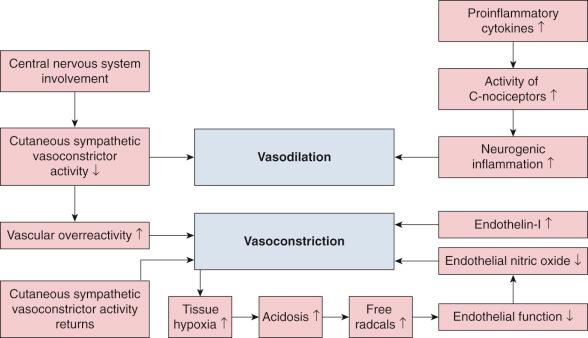
An exaggerated inflammatory response to injury or surgery in patients diagnosed with CRPS has been noted for many years. Classic inflammation is marked by immune cells such as lymphocytes, phagocytes, and mast cells that secrete proinflammatory cytokines. Recent studies have shown that inflammatory mediators are elevated in CRP-affected limbs, including interleukin-6 and tumor necrosis factor α (TNF α), as well as activated monocytes and macrophages. However, systematic parameters of classic inflammation, including white blood cell count and C-reactive protein, are normal in CRPS patients. It therefore appears that a neurogenic inflammatory process may instead occur, which may explain many of the signs and symptoms of CRPS.
Trauma causes the release of nerve growth factor and proinflammatory cytokines, both of which can activate and sensitize peripheral nociceptors. Neurogenic inflammation arises from the local release of inflammatory mediators (neuropeptides) from nociceptive C-fibers such as the substance P, calcitonin gene-related peptide (CGRP), and bradykinin. These neuropeptides have been shown to be elevated in CRPS patients. They evoke vasodilation in acute CRPS and may cause edema, sweating, elevated skin temperature, erythema, and hair growth. Also, aberrant neuropeptide signaling may cause decreased limb temperature and trophic changes.
Central sensitization is a process in which the excitability of neurons in the spinal cord is increased. In the Raja model, pain receptors (nociceptors) upregulate their α receptors. Because the body is constantly sending sympathetic signals, these nociceptors are being constantly stimulated, which reduces the CNS threshold for perceiving pain. Changes occur in the dorsal root ganglion. The mechanoreceptors responsible for light touch sensation and thermoreceptors responsible for cold sensation instead produce an abnormal painful response when they stimulate the sensitized central pain neurons. The term central sensitization may be used to explain the clinical findings of allodynia and hyperalgesia.
In the Raja model, treatment by sympathetic blockade is effective by the production of a temporary inhibition of norepinephrine release. By temporarily blocking the release of catacholamines, the sympathetic block relieves pain. By allowing the CNS to experience relief from pain, the central pain neurons may be desensitized (downregulation of α receptors), resulting in a long-term improvement in the painful response to light touch.
The change in regulation of α receptors also explains the change in appearance of the limb over time. Initially, an increase in α receptors causes excess stimulation, which presents as a red, warm, and swollen limb (increased sympathetic function). Later, as the body adjusts and downregulates the expression of α receptors, the same limb will take on a blue, cool, and contracted appearance. Secondary psychological problems such as pain-related fear and movement anxiety have been associated with central sensitization. Changes in somatosensory processing have been shown to occur at the cortical level in CRPS-I of the upper extremity.
Many studies have stressed the important role of the CNS in the disease process of CRPS. The question of whether the changes that occur in the CNS do so as a direct response to the initiating event or subsequently over time remains unanswered. There are changes in central sympathetic, somatosensory, and motor systems that many believe imply alterations occur in the CNS. Many patients develop muscle paresis in the affected limb, which results in restrictions in active range of motion. Studies have reported that 9% to 49% of patients with CRPS develop movement disorders such as loss of voluntary control, bradykinesia, myoclonus, dystonia, and tremor. Central sensitization occurs as a result of functional and structural changes in the CNS. The pattern of sensory disturbances is usually not limited to the area of a single peripheral nerve but are rather in a wider area detected as brush-evoked allodynia. Hemisensory deficits have been reported, with sensory disturbances detected in the contralateral normal limb. Thermoregulatory reflexes are disturbed in the distal areas of the affected limbs, which investigators attributed to alterations in cutaneous vasoconstrictor neurons. In addition, up to 50% of patients with chronic CRPS-I develop hypoesthesia on the affected side of the body, which is believed to be caused by changes in central processing of tactile stimuli at the thalamic or cortical level.
Alterations in the CNS are manifest in CRPS studies that have demonstrated impaired perceptual learning, global cognitive impairment, altered brain activation patterns, changes in cerebral blood flow, and body perception disturbances ( Fig. 40-9 ). Cortical reorganization is a potential consequence of this disorder, with functional magnetic resonance imaging (MRI) studies providing evidence of alterations in the primary somatosensory cortex (S1) contralateral to the CRPS affected side. Changes have also been detected in the motor cortex during finger tapping tests. Altered central opioidergic neurotransmission was reported in one study from ligand positron emission tomography studies. Abnormal thalamocortical activity (spontaneous abnormal low frequency rhythmic magneto-encephalographic activity) was detected in another study of CRPS patients. Patients may abnormally activate the dorsolateral and ventromedial prefrontal cortex, regions important for perceptual learning and emotional decision making.
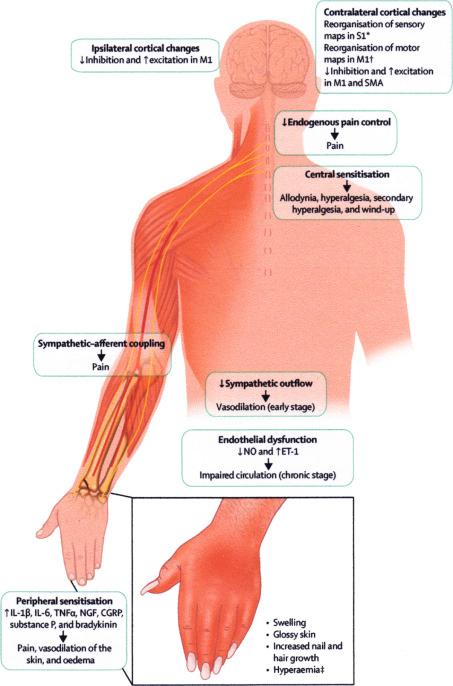
The sensory representation of the CRPS-affected limb is frequently altered in that the limb feels disfigured and out of place. From a psychophysical standpoint, studies have reported that high percentages of patients (54%-84%) have cognitive and/or motor neglect–like symptoms in which the affected limb may feel foreign, and directed mental and visual attention are required to move the limb. Patients may perceive the affected limb to be larger than it actually is or that the limb is altered in shape and appearance. In one study, patients with long-standing CRPS expressed strong negative feelings about the affected limb, and many wanted it amputated. Libon and associates noted that significant neuropsychological deficits were present in 65% of 137 patients with chronic CRPS. These included reduced performance on tests that assessed working memory/mental search and problems on tests of naming and memory. These impairments were not associated with spread of CRPS to other limbs, duration of symptoms, or medication use. These authors concluded that the data was consistent with recent MRI studies suggesting the disorder involves the CNS and involves a large amount of cortical and subcortical areas.
The concept that limb ischemia or hypoxia occurs in CRPS-affected limbs is associated with the inflammatory hypothesis. There is the possibility that the abnormal inflammation leads to a compartment-syndrome scenario that results in oxygen–free radical–induced microvascular damage. This in turn leads to further tissue ischemia and nociceptor excitation. The presence of ischemia, with decreased capillary oxygenation, has been shown in superficial skin layers in CRPS-affected limbs and may also be present in deeper tissues. In muscle, nuclear magnetic resonance spectroscopy showed signs of acidosis and impaired high-energy phosphate metabolism in amputated specimens from patients with chronic CRPS. Hypoxia and its associated acidosis and free radical formation can trigger primary afferents to cause severe pain. It has been proposed to be caused by extreme vasoconstriction or from a local imbalance between endothelial factors.
The association between psychological factors and CRPS-I is controversial because of the lack of high quality studies. Historically, many believed that preexisting psychological disorders played a role in the development of this disorder. However, a recent systematic review encompassing 31 studies conducted by Beerthuizen and associates refuted this bias. This investigation found no evidence for a relationship between CRPS-I and depression, anxiety, neuroticism, anger, obsessive-compulsive behavior, comatization, hostility/anger, interpersonal sensitivity, extraversion/introversion, or paranoia. There did appear to be a relationship between stressful life events that were soon followed by the development of this disorder. This association has been hypothesized to be caused by a repeatedly triggered sympathetic system (from the stressful event), which develops an altered local catecholamine responsiveness, resulting in prolonged increased autonomic arousal. A recent prospective study found a positive association between the development of CRPS-I after a distal radius fracture and patients with an “anxious personality,” or a high level of general anxiety. However, there was no significant relationship between a history of psychiatric disorder and the development of CRPS-I.
There is a relevant question of the contribution of longstanding CRPS to the development of psychological disturbances. There are psychophysiological mechanisms that we previously discussed that may lead to changes in personality and management of anger. In chronic cases, extreme fear of pain may lead to disuse of the affected extremity resulting in prolonged immobilization that leads to decreased active range of motion, diminished nutritive blood flow, and trophic alterations ( Fig. 40-10 ).
![FIG 40-10, Possible paths for interaction among proposed pathogenic mechanisms of complex regional pain syndrome. 1. Hypoxia may trigger inflammatory response (Interaction: hypoxia inflammation [classic and neurogenic]). 2. Continuous nociceptive input by hypoxia, inflammation, or sympathetic stimulation may lead to sensitization and alterations in cortical organization of sensory and motor units. (Interaction: hypoxia, inflammation, and autonomic dysfunction somatic neuronal dysfunction [sensitization and cortical reorganization]). 3. Neuropeptides (substance P [SP]) released in dorsal horn may facilitate sensitization through interaction with NK-1 and NMDA) receptors. (Interaction: inflammation [neurogenic] somatic neuronal dysfunction [sensitization]). 4. Sympathetic dysfunction (either central sympathetic hyperactivity or increased peripheral adrenergic receptor hypersensitivity) may cause hypoxia because of impaired nutritive blood flow. (Interaction: autonomic dysfunction hypoxia). 5. Adrenergic receptors can be expressed on immune cells, and catecholamines can modulate cellular immunity, and it also has been speculated that inflammation may change sensitivity or expression of α-adrenergic receptors on nociceptive fibers. (Interaction: autonomic dysfunction inflammation [classic]). 6. Cytokines influence the balance of nitric oxide (NO) to endothelin (ET). (Interaction: [classic] inflammation hypoxia). 7. Psychological distress may influence sympathetic outflow and levels of catecholamines. (Interaction: psychopathology autonomic dysfunction). 8. Severe chronic pain and disability may cause psychological distress. (Interaction: somatic neuronal dysfunction [sensitization] psychopathology). 9. Fear of movement may result in the accumulation of inflammatory mediators and free radicals and prevent desensitization. (Interaction: psychopathology inflammation and hypoxia and somatic neuronal dysfunction ). CGRP , Calcitonin gene-related protein; IL , interleukin; Mg 2 , magnesium ions; NK-1R , neurokinin-1 receptor; NMDA-R , N-methyl-D-aspartate receptor; NPY , neuropeptide Y; SP , substance P; TNF α, tumor necrosis factor α; VIP , vasoactive intestinal pain. FIG 40-10, Possible paths for interaction among proposed pathogenic mechanisms of complex regional pain syndrome. 1. Hypoxia may trigger inflammatory response (Interaction: hypoxia inflammation [classic and neurogenic]). 2. Continuous nociceptive input by hypoxia, inflammation, or sympathetic stimulation may lead to sensitization and alterations in cortical organization of sensory and motor units. (Interaction: hypoxia, inflammation, and autonomic dysfunction somatic neuronal dysfunction [sensitization and cortical reorganization]). 3. Neuropeptides (substance P [SP]) released in dorsal horn may facilitate sensitization through interaction with NK-1 and NMDA) receptors. (Interaction: inflammation [neurogenic] somatic neuronal dysfunction [sensitization]). 4. Sympathetic dysfunction (either central sympathetic hyperactivity or increased peripheral adrenergic receptor hypersensitivity) may cause hypoxia because of impaired nutritive blood flow. (Interaction: autonomic dysfunction hypoxia). 5. Adrenergic receptors can be expressed on immune cells, and catecholamines can modulate cellular immunity, and it also has been speculated that inflammation may change sensitivity or expression of α-adrenergic receptors on nociceptive fibers. (Interaction: autonomic dysfunction inflammation [classic]). 6. Cytokines influence the balance of nitric oxide (NO) to endothelin (ET). (Interaction: [classic] inflammation hypoxia). 7. Psychological distress may influence sympathetic outflow and levels of catecholamines. (Interaction: psychopathology autonomic dysfunction). 8. Severe chronic pain and disability may cause psychological distress. (Interaction: somatic neuronal dysfunction [sensitization] psychopathology). 9. Fear of movement may result in the accumulation of inflammatory mediators and free radicals and prevent desensitization. (Interaction: psychopathology inflammation and hypoxia and somatic neuronal dysfunction ). CGRP , Calcitonin gene-related protein; IL , interleukin; Mg 2 , magnesium ions; NK-1R , neurokinin-1 receptor; NMDA-R , N-methyl-D-aspartate receptor; NPY , neuropeptide Y; SP , substance P; TNF α, tumor necrosis factor α; VIP , vasoactive intestinal pain.](https://storage.googleapis.com/dl.dentistrykey.com/clinical/DiagnosisandTreatmentofComplexRegionalPainSyndrome/9_3s20B9780323329033000408.jpg)
Studies have shown evidence of antineuronal autoantibodies in 30% to 90% of CRPS patients. A randomized controlled trial reported that low-dose intravenous immunoglobulin reduced pain in chronic CRPS, considered circumstantial evidence for an autoimmune etiology. Several case reports have been published that report the onset of CRPS in patients with an autoimmune disease. A recent investigation suggested that antigens for the autoantibodies found in CRPS patients might be α adrenoceptors and muscarinergic acetylcholine receptors. The question of autoimmune mechanism involvement in the pathophysiology of CRPS requires further study.
Diagnosis CRPS-I and CRPS-II based mostly on clinical findings, Budapest clinical diagnostic criteria. No laboratory marker available. Early diagnosis highly important.
Women have a higher incidence.
Usual trigger is trauma, surgery, immobilization.
Rule out all other possible diseases and disorders.
EGM studies, diagnostic nerve blocks indicate CRPS-II.
Most common finding is pain disproportionate to the inciting event: burning and shooting, or as deep, constant, and aching.
Changes in skin temperature and color, extraarticular and painful swelling, frequent findings.
Hyperalgesia and/or allodynia usually present, hypoalgesia may also exist.
Motor abnormalities: decreased active range of motion, action tremors, myoclonus, hyperreflexia, muscle spasm, voluntary guarding.
Tests: x-rays, MRI, bone scan, diagnostic nerve block, skin surface temperature.
Become a Clinical Tree membership for Full access and enjoy Unlimited articles
If you are a member. Log in here